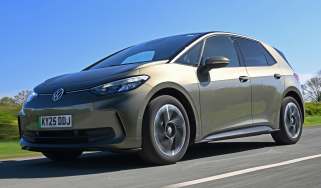Porsche Panamera Sport Turismo review - MPG, CO2 and Running Costs
Hybrid models offer significantly better economy and Benefit-in-Kind tax breaks, but are less involving to drive

While the Panamera 4 E-Hybrid might not be the best driver’s car in the Sport Turismo range, it is likely to be the most popular model thanks to its lower running costs. If you have a relatively short commute you can take advantage of its all-electric running capability, and with a WLTP economy figure of between 78.5 and 85.6mpg, it offers significant fuel savings over its conventionally powered cousins. It’s also by far the most cost-effective machine in terms of Benefit-in-Kind (BiK) company car tax with a 16 per cent BiK rate thanks to its 60-62g/km CO2 emissions figure.
Despite its monumental performance, the Turbo S E-Hybrid could also potentially be a relatively ‘sensible’ purchase, with official economy figures of between 72.4 and 74.3mpg and a BiK rating of 19 per cent. However, the purchase price of over £140,000 means company car tax will still be a hefty proposition. And, naturally enough, if you use its performance potential you’re highly unlikely to achieve anything near those official economy figures.
The four conventionally-powered Sport Turismos are closely matched on official WLTP economy figures, with the 4 and 4S being marginally more fuel efficient that the two 4.0-litre V8s in the GTS and Turbo. Best economy is quoted at 25.6mpg for the Panamera 4, while the Turbo and GTS have worst-case official figures of 22.2mpg. As with the Hybrid models, should you delve into their considerable performance envelopes you’ll return significantly worse economy.
Used - available now

2023 BMW
5 Series
43,680 milesAutomaticDiesel2.0L
Cash £23,850
2021 DS
DS 7 CROSSBACK
37,756 milesAutomaticPetrol1.6L
Cash £14,729
2019 Mercedes
AMG E63 Estate (2020-2023)
34,645 milesAutomaticPetrol4.0L
Cash £38,531
2020 Mercedes
E-Class Coupe
20,528 milesAutomaticDiesel2.0L
Cash £26,069All Sport Turismos bar the E-Hybrids attract a BiK rate of 37 per cent, which will make them an expensive company car choice. Thanks to their high prices, models with purely internal combustion engines attract high annual VED rates of £450, while buyers choosing the hybrid models face bills of £440 a year.
Insurance
As you might expect, a sporting estate with high levels of performance and high purchase prices is going to be expensive to insure. Every model in the Sport Turismo range falls into the top insurance bracket, group 50, so you’d be wise to get some quotes before signing on the dotted line.
While the Panamera Sport Turismo has very few direct competitors, most cars in this price range and with this performance potential will attract similarly high insurance rates. In addition, most insurers will probably require a Thatcham-approved tracking system to be fitted.
Depreciation
As the Sport Turismo is still a very new car, it’s difficult to gauge how it will perform in regard to depreciation. But for the hatchback Panamera, the residual value after three years is expected to be between 48 and 53 per cent. While this will represent a significant sum of money, it is better than average for the class where expensive models traditionally depreciate quite heavily during their first years on the road.








